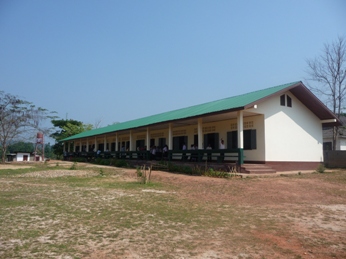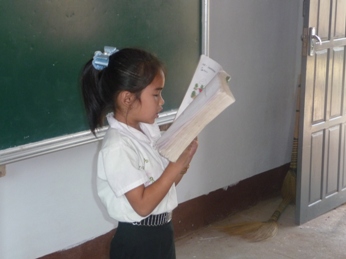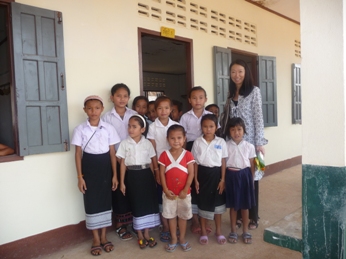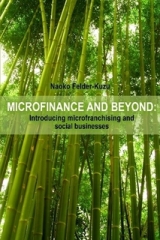
Kiva.org, the world’s first microlending website announced today its entry into the education field by offering a pilot for student microloans in 3 countries. So beginning today anyone can make a loan starting at USD 25 to students that are selected by Kiva’s first 3 education field partners; Fundacion Paraguaya (Paraguay) IMPRO (Bolivia) and Ameen s.a.l. (Lebanon). Kiva.org an innovative social enterprise created a movement to connect people around the world through lending to alleviate poverty. In only 5 years, Kiva.org has provided over USD 160 mn in loans to 415,000 microentrepreneurs around the world and these loans (which are as little as USD 25) have come from close to half a million lenders spread in 206 countries!
“The pilot was born as a natural extension of Kiva’s mission to connect people, through lending, to alleviate poverty. Kiva Student Microloans give recipients the opportunity to gain new knowledge and skills through higher education or vocational training. As a result, these individuals will be better positioned to find jobs, support their families and grow their communities — and ultimately make a real difference in the relief of global poverty.” (source: Kivablog)
Author Archives: microfinance
IDEO launches OpenIDEO an online platform where we can design, collaborate and create solutions and social good
Earlier this month, IDEO, the leading global design consultancy launched OpenIDEO, a collaborative platform to design and create solutions to the world’s toughest challenges. This platform is cool. It starts with a big question (the challenge that needs a creative solution) and uses the design process; brainstorming, conceptualizing and evaluating to create with the online community innovative solutions. A very interesting point is that anyone that collaborates can get recognized accordingly to one’s contribution. OpenIDEO kicked off with Jamie Oliver’s challenge “How can we raise kid’s awareness on the benefits of fresh food so they can make better choices?” so tackling obesity. The second challenge is “How to increase the availability of affordable learning tools and services for students in the developing world?” by Enterterprising Schools, a project of Grey Matters Capital. It reminded me a lot of Ashoka’s Changemakers in that it crowdsources ideas/proposals and let the online community collaborate to create solutions. OpenIDEO is making it easier for everyone to become a changemaker!
Turbulent month in the microfinance world: Death of BANEX and the successful IPO of SKS
This month we have seen the death of a large microfinance institution BANEX (formerly Findesa), once the leading Nicaraguan MFI was forced into liquidation by the Nicaraguan Banking Superintendant (NBS) after defaulting on its creditors. Findesa was founded in 2002 had a spectacular growth and a remarkable track record til early 2008. They were granted the banking licence in September 2008 and changed its name to BANEX. The portfolio quality of Nicaraguan MFIs deteriorated very quickly in the past 2 years due to 1)the negative impact of the global financial crisis especially seen by the decline of remittances from Nicaraguans working in the USA, and 2) the “no pay movement” in the north and central parts of the country. Furthermore, Banex was hit by its product mix with high exposure to small and medium enterprises and high concentration in livestock loans. According to the national newspaper, NBS stated that all 3000 depositors of Banex were paid back in full. For more information please read David Roodman’s excellent writeup and the short note from Microrate
The good news. The long awaited IPO of SKS Microfinance took place and the shares made an impressive debut on the Bombay and National Stock Exchange of India on Aug 16th. The IPO was over 13 times subscribed and the shares closed the first day with an 11% premium. The valuations are much higher than Compartamos and the topic of MFIs going public is actively debated as industry players are divided in their views.
The Stanford Executive Program in Social Entrepreneurship

From June 20th to July 2, I attended the Executive Program in Social Entrepreneurship (EPSE) at Stanford Graduate School of Business which was one of the greatest learning experiences I’ve ever had. The courses of this rich and intensive program were interactive and diverse covering topics such as; mission (Jim Phills), strategy and execution (Robert Burgelman), Innovation (Jim Phills), social entrepreneurship by design (Jim Patell) how to change things when change is hard (Chip Heath), building and leading effective teams (Deb Gruenfeld), the power of social media (Jennifer Aaker), role of power and influence for leading large systems change (Jeff Pfeffer), balancing social and business objectives (Bill Barnett). In addition to the inmense knowledge that the class acquired learning from the superb Stanford faculty, the participating 48 social entrepreneurs that traveled from 15 different countries learned so much from each other and formed long-lasting friendships. One such great social entrepreneur and a dear classmate, Ben Stone, from Indego Africa has written an excellent summary of this program. Thanks Ben!
Reflections after 2010 Skoll World Forum

This year’s title (theme) of the Skoll World Forum was “Catalysing Collaboration” and I believe it fully lived up to it. The program reflected and encouraged much more interaction than in previous years. No doubt the OxfordJam programmes running parallel to the forum and the fact that many of us got stranded due to the volcano eruption resulted in further discussions and collaboration. There are many videos and podcasts for anyone who would like to see or hear some sessions. One of the most inspiring speeches was from Caroline Casey delivered at the closing plenary. Blog discussions after the Forum (see socialedge ) are also very interesting to follow. There seems to be an amazing energy and momentum which is expanding the sphere of social entrepreneurship from a “small club of unreasonable people” to mainstream. Perhaps the definition of “social entrepreneur” might not be enough to accomodate the many people that are joining the movement. Call them changemakers (as Bill Drayton refers to them) or maybe a new word like social interpreneurship (see Peter Deitz’s blog): what matters is that with more people trying to make a difference and with more interaction and collaboration there is renewed hope to tackle the enormous problems that society faces today.
Socential: a Swiss start-up launches marketplace for social entrepreneurship
(Disclosure: the author is in the management team and in charge of social investment management at Socential)
Socential, a Swiss start-up has launched an online platform to connect social investors to social entrepreneurs projects aiming to empower system changing solutions to the world’s social problems. The platform was launched as a pilot in January this year featuring Swiss social entrepreneur’s projects and the latest release this April has featured projects from the internationally acclaimed social entrepreneur Bunker Roy from Barefoot College.
New interesting publications on microfinance
Some interesting reports/studies have been recently published. This was brought to my attention by Microcapital.
Microfinance’s Midlife Crisis from the Wall Street Journal , Assessing the Role of Microfinance in Fostering Adaptation to Climate Change by Shardul Agrawala and Maëlis Carraro, and Microfinance and Inequality by the Macrothink Institute written by Hisako Kai and Shigeyuki Hamori.
Visit to Room to Read school in Laos

On February 8th we visited the offices of the Room to Read in Laos and the Napheui Primary School (90 minutes by car from Vientianne) which we supported to build with some help from our friends in Switzerland. Walking up towards the school building and hearing the children either reading out loud, responding to questions posed by the teachers, or just simply giggling made us smile. By the way, the school building has 6 rooms – 5 classrooms and a library. In Laos, primary school takes 5 years. 
Even though we knew that Room to Read works effectively together with the community and the local government, actually seeing how the stakeholders collaborate was a great experience. We were received like “dignitaries” by students, local government officials and senior representatives of the village.
 Some statistics that we got from the village chief’s presentation: The population of the village is 891, there are 140 families, 104 children attend “our” primary school. Officially, 57 girls, the rest boys. (p.s. it felt like there were quite a few more girls than boys at least on the day we visited) We are extremely happy that we could be part of such a wonderful project. See more pictures of the visit.
Some statistics that we got from the village chief’s presentation: The population of the village is 891, there are 140 families, 104 children attend “our” primary school. Officially, 57 girls, the rest boys. (p.s. it felt like there were quite a few more girls than boys at least on the day we visited) We are extremely happy that we could be part of such a wonderful project. See more pictures of the visit.
Revisiting the impact of microfinance
A number of studies and articles have been appearing since last year questioning the impact of microcredit – microfinance. One of the most recent reports “Does Microcredit Really Help Poor People?” written by the seasoned microfinance expert Richard Rosenberg provides an excellent overview of the studies and his view on this subject. According to this report the claim in doubt is whether microfinance (or the microloans) is the cause for the economic improvement (increase in income and consumption, moving people out of poverty) as well as positive impact in health, education and social empowerment. The problem being that scientific testing of the impact of microcredit is very difficult (and therefore proving the claims are difficult). Rosenberg ends the report with the following words;
“Small one-time subsidies – leverage large multiples of unsubsidized funds – producing sustainable delivery year after year of highly valued services that help hundered of millions of people – keep their consumption stable, finance major expenses, and cope with shocks – despite incomes that are low, irregular, and unreliable.
All and all isn’t this a pretty impressive value proposition, even if we eventually find out that microfinance doesn’t raise income the way some of its proponents have claimed?”
In retrospect, it is very likely that in the past years the rising popularity of microfinance and its impact had become over-blown. Proponents of microfinance (including this author), in their quest of raising awareness of this powerful and effective tool to improve the life of the BOP, have been too enthusiastic and most likely also helped create the overhyped state. So the recent critical articles are deflating the overly high expectations that were built on microfinance and its impact. This is a healthy sign. I thank David Roodman and his excellent open-book blog which has been providing a critical view on the many issues surrounding the impact of microfinance.
Book: Microfinance and Beyond: Introducing microfranchising and social businesses

This book introduces innovative social/business models that provide sustainable solutions to the problem of poverty and portrays the insipiring people behind them.You can find an update on microfinance, BOP (base of the pyramid) initiatives, and microfranchising all which are improving the lives of the 4 billion people living at the BOP. VisionSpring, an innovative social microfranchising enterprise with the mission to reduce poverty and generate opportunity through the sale of affordable reading glasses is featured as a model case. The aim of this book was to share my insights on 1) how the business and social worlds have been converging, setting the stage for these innovative models to emerge, 2) how these models, together with the advent of Web 2.0, are creating a strong and positive movement towards a more responsible, sustainable and kinder world and 3) how all of us could make a difference.
This book is the updated English version of the German book that was published last year. I used lulu.com to publish this and I can recommend it.
